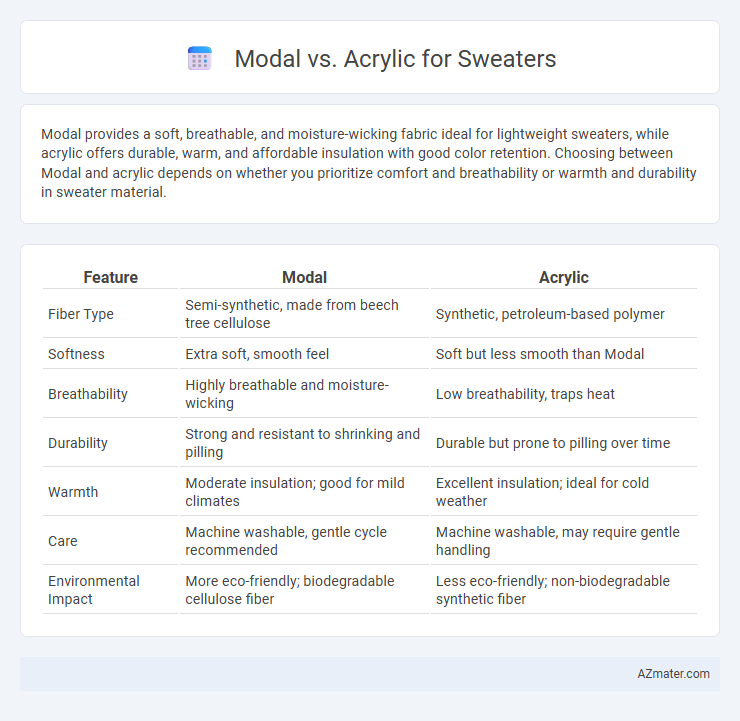Modal provides a soft, breathable, and moisture-wicking fabric ideal for lightweight sweaters, while acrylic offers durable, warm, and affordable insulation with good color retention. Choosing between Modal and acrylic depends on whether you prioritize comfort and breathability or warmth and durability in sweater material.
Table of Comparison
| Feature | Modal | Acrylic |
|---|---|---|
| Fiber Type | Semi-synthetic, made from beech tree cellulose | Synthetic, petroleum-based polymer |
| Softness | Extra soft, smooth feel | Soft but less smooth than Modal |
| Breathability | Highly breathable and moisture-wicking | Low breathability, traps heat |
| Durability | Strong and resistant to shrinking and pilling | Durable but prone to pilling over time |
| Warmth | Moderate insulation; good for mild climates | Excellent insulation; ideal for cold weather |
| Care | Machine washable, gentle cycle recommended | Machine washable, may require gentle handling |
| Environmental Impact | More eco-friendly; biodegradable cellulose fiber | Less eco-friendly; non-biodegradable synthetic fiber |
Introduction to Modal and Acrylic Fabrics
Modal fabric, derived from beech tree pulp, offers exceptional softness, breathability, and moisture-wicking properties, making it ideal for lightweight, comfortable sweaters. Acrylic fibers, a synthetic polymer, provide durability, elasticity, and resistance to wrinkles and mildew, often used to mimic the feel of wool in sweater production. Both fabrics serve distinct purposes in sweater manufacturing, with Modal excelling in comfort and breathability while Acrylic emphasizes resilience and easy care.
Key Differences Between Modal and Acrylic
Modal is a semi-synthetic fiber derived from beech tree cellulose known for its exceptional softness, breathability, and moisture-wicking properties, making it highly comfortable for sweaters. Acrylic, a synthetic polymer, offers durability, lightweight warmth, and resistance to moths and mildew but lacks the natural breathability and softness of modal. Modal sweaters typically provide better drape and a more luxurious feel, while acrylic sweaters excel in affordability and ease of care.
Material Origins: Natural vs Synthetic
Modal fibers derive from natural cellulose found in beech trees, making it a semi-synthetic fabric with eco-friendly origins and a smooth, breathable texture ideal for sweaters. Acrylic is a fully synthetic fiber produced from polymer compounds, resembling wool but often less breathable and prone to pilling. Understanding the distinction between modal's natural-based source and acrylic's chemical synthesis helps in choosing warmer, softer, and more sustainable sweater materials.
Softness and Comfort Comparison
Modal fabric offers superior softness compared to acrylic, providing a silky smooth texture that feels gentle against the skin. Acrylic, while lightweight and warm, tends to be less breathable and can feel rougher or itchier, especially for those with sensitive skin. Sweaters made from modal are often preferred for enhanced comfort due to their moisture-wicking properties and excellent drape, making them ideal for prolonged wear.
Durability and Longevity in Sweaters
Modal fibers offer exceptional durability and maintain their softness after multiple washes, making them ideal for sweaters that need long-lasting comfort and shape retention. Acrylic, while generally less expensive and resistant to moth damage, tends to pill and degrade more quickly, reducing the sweater's lifespan under regular wear. Sweaters made from modal blend fabrics typically provide superior longevity due to enhanced fiber strength and resistance to shrinkage compared to purely acrylic garments.
Breathability and Moisture-Wicking Properties
Modal fabric offers superior breathability and moisture-wicking properties compared to acrylic, making it ideal for sweaters worn in varying temperatures. Modal's natural fibers allow air to circulate efficiently and absorb moisture away from the skin, enhancing comfort during physical activity or warmer conditions. Acrylic, while durable and warm, lacks the same level of moisture management and breathability, often resulting in a less comfortable experience in humid or active wear scenarios.
Warmth Retention: Which Is Cozier?
Modal fabric offers moderate warmth retention due to its smooth, breathable fibers that provide comfort without overheating. Acrylic, known for its excellent insulation properties, traps heat effectively, making it a cozier option in cold weather. Sweaters made from acrylic typically deliver superior warmth retention compared to modal garments.
Maintenance and Care Instructions
Modal sweaters require gentle washing in cold water to maintain fabric softness and avoid shrinkage, with air drying recommended to preserve shape and prevent damage. Acrylic sweaters are easier to care for, allowing machine washing on a gentle cycle, but should be dried flat to prevent stretching and pilling. Both fabrics benefit from avoiding high heat during washing and drying to extend garment lifespan and maintain appearance.
Environmental Impact and Sustainability
Modal fabric, derived from beech tree pulp, is considered more sustainable due to its biodegradable properties and lower water consumption during production compared to conventional cotton. Acrylic, a synthetic fiber made from petroleum-based chemicals, has a significantly higher environmental impact due to its non-biodegradable nature and contribution to microplastic pollution. Choosing modal over acrylic for sweaters supports eco-friendly fashion by reducing resource depletion and minimizing waste in landfills and oceans.
Choosing the Right Fabric for Your Sweater
Choosing between modal and acrylic fabric for your sweater involves considering softness, durability, and breathability. Modal, made from beech tree pulp, offers a silky texture and excellent moisture absorption, making it ideal for comfort and breathability. Acrylic provides affordability, vibrant color retention, and resistance to moths, but may lack the natural softness and breathability of modal.

Infographic: Modal vs Acrylic for Sweater
 azmater.com
azmater.com